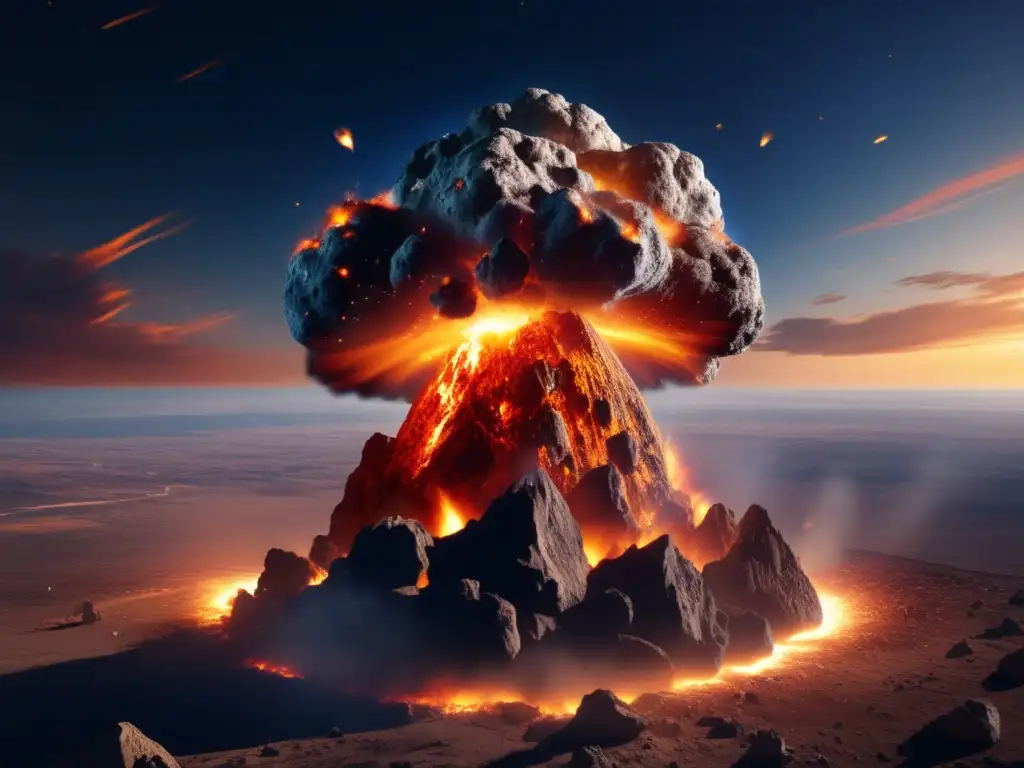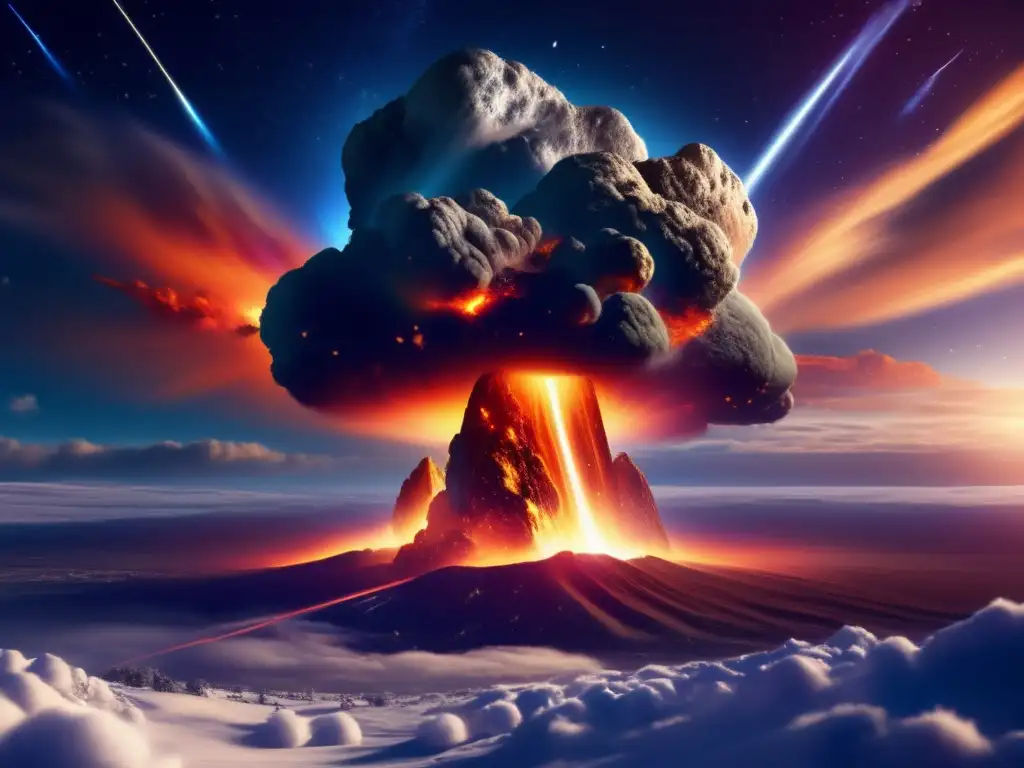Asteroids And The Atmosphere: Understanding Entry And Impact

Introduction
Asteroids are more than just celestial objects that revolve around the sun. They have had a major impact on life on Earth, as evidenced by the numerous craters that dot our planet's surface. When an asteroid enters Earth's atmosphere, it interacts with the air in a variety of ways, leading to its eventual impact on the planet's surface. In this article, we will explore how asteroids enter and interact with Earth's atmosphere and what factors determine their impact.
How do Asteroids Enter Earth's Atmosphere?

The Trajectory of an Asteroid
Asteroids typically enter Earth's atmosphere at very high speeds and at steep angles. The angle of entry plays a significant role in determining the trajectory of the asteroid. A shallow angle will result in the asteroid skipping off the atmosphere and back into space, while a steeper angle will cause it to plunge deeper into the atmosphere and ultimately impact the Earth's surface.
Asteroid Composition and Size
The composition and size of an asteroid also play a crucial role in determining its entry trajectory. Smaller asteroids tend to burn up in the atmosphere due to friction with the air molecules, while larger asteroids are able to withstand the heat and pressure and continue on their trajectory towards Earth's surface. Additionally, an asteroid's composition can also affect its entry into the atmosphere. For instance, iron-rich asteroids have a better chance of surviving entry due to their strength and durability.
Atmospheric Conditions
The atmospheric conditions at the time of impact can also affect an asteroid's entry trajectory. Winds, temperature variations, and changes in atmospheric pressure can all alter an asteroid's path and impact point. A strong headwind, for instance, can slow the asteroid down and cause it to impact at a shallower angle, while a tailwind can increase its speed and result in a steeper impact angle.
What Happens When an Asteroid Enters Earth's Atmosphere?

Atmospheric Entry Effects
When an asteroid enters Earth's atmosphere, it undergoes a variety of changes due to its interaction with the air molecules. Initially, the asteroid experiences a strong deceleration as it collides with the air molecules in its path. This results in a high amount of friction, which causes the asteroid to heat up rapidly. Due to the intense heat, the asteroid's surface begins to vaporize, producing a bright trail of glowing gas and debris behind it. This trail is known as a meteor or shooting star and is visible to observers on the ground.
The Role of Shock Waves
As the asteroid continues its descent through the atmosphere, it generates shock waves that travel ahead of it. These shock waves produce a sonic boom that is heard by observers on the ground. In addition, the shock waves can cause damage to buildings and other structures below, particularly if the asteroid impacts nearby.
Impact on Environment
The impact of an asteroid on the environment can be significant, depending on its size and speed. Small asteroids may burn up entirely before reaching the ground, resulting in no impact at all. However, larger asteroids can cause widespread damage and destruction. The impact can trigger fires, tsunamis, earthquakes, and volcanic eruptions, leading to catastrophic consequences for life on Earth.
How do Scientists Study Asteroid Impacts?

Asteroid Observation Techniques
To better understand asteroid impacts, scientists use a variety of observation techniques. One such technique involves using ground-based telescopes to track the movements and trajectories of asteroids. Another method involves deploying spacecraft to study asteroids up close and collect samples of their composition. These data can then be used to better understand the potential impact that an asteroid could have on Earth.
NASA's Planetary Defense Program
NASA's Planetary Defense Program is dedicated to identifying and tracking potentially hazardous asteroids and developing strategies to mitigate their impact on Earth. The program uses a combination of ground-based and space-based instruments to detect and track asteroids and develop models of their potential impact on Earth. In addition, the program is also exploring various methods to deflect or redirect asteroids that are headed towards Earth.
Frequently Asked Questions

-
Can an asteroid enter Earth's atmosphere without being detected?
Yes, while most asteroids can be detected using current technology, some may go undetected until they are relatively close to Earth. This underscores the importance of continued investment in asteroid detection and monitoring programs.
-
What is the likelihood of a catastrophic asteroid impact on Earth?
The likelihood of a catastrophic asteroid impact is low, but not zero. Currently, there are no known asteroids that pose an imminent threat to Earth, but continued monitoring and modeling will be necessary to ensure that we are prepared for any potential impact.
-
What is the difference between a meteor, meteorite, and asteroid?
A meteor is a bright trail of glowing gas and debris produced by an asteroid as it enters Earth's atmosphere. A meteorite is any part of an asteroid that survives its entry into the atmosphere and impacts the Earth's surface. An asteroid is a small, rocky object that orbits the sun.
-
Are there any known methods to prevent an asteroid impact?
There are several methods that have been proposed to deflect or redirect asteroids, including using spacecraft to nudge the asteroid off its trajectory, detonating a nuclear device near the asteroid, or using a gravity tractor to alter its course. However, currently, none of these methods have been tested at a large scale.
-
What can we do to prepare for a potential asteroid impact?
Preparing for a potential asteroid impact involves a combination of detection, tracking, modeling, and developing strategies to mitigate the impact. Continued investment in programs like NASA's Planetary Defense Program will be crucial to ensuring our preparedness for a potential impact.
Conclusion
Asteroids are both fascinating and potentially dangerous objects that require our continued attention and study. Understanding how they enter and interact with Earth's atmosphere is crucial to predicting their impact and developing strategies to mitigate that impact. While the likelihood of a catastrophic asteroid impact is low, continued investment in asteroid detection and monitoring programs will be vital to ensuring our preparedness for any potential impact.
We invite you to share your thoughts and questions in the comments section, and encourage you to stay informed about the latest developments in asteroid research by subscribing to www.asteroidrealm.com and following us on social media.
Additional Resources

For those interested in learning more about asteroids and their impact processes, we recommend the following resources:
- NASA's Planetary Defense Program
- ESA's Asteroid Impact Deflection Mission (AIDA)
- Elsevier Publisher Series in Astronomy and Planetary Sciences
 Space Invaders: How Asteroids Have Shaped Our World
Space Invaders: How Asteroids Have Shaped Our World Nuclear Showdown: Comparing Asteroid Impacts To Atomic Explosions
Nuclear Showdown: Comparing Asteroid Impacts To Atomic Explosions Asteroids Vs Comets: Comparing Impact Events
Asteroids Vs Comets: Comparing Impact EventsIf you want to discover more articles similar to Asteroids And The Atmosphere: Understanding Entry And Impact, you can visit the Asteroid Impacts category.
Leave a Reply

Articulos relacionados: